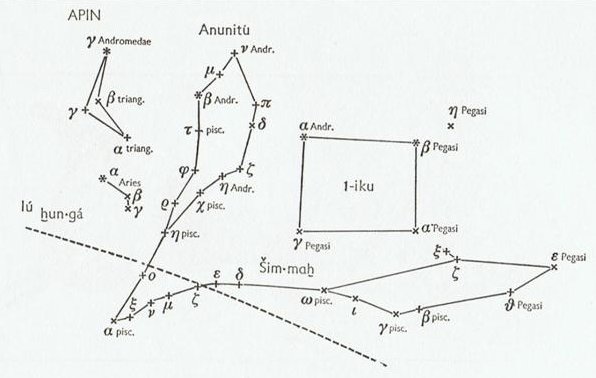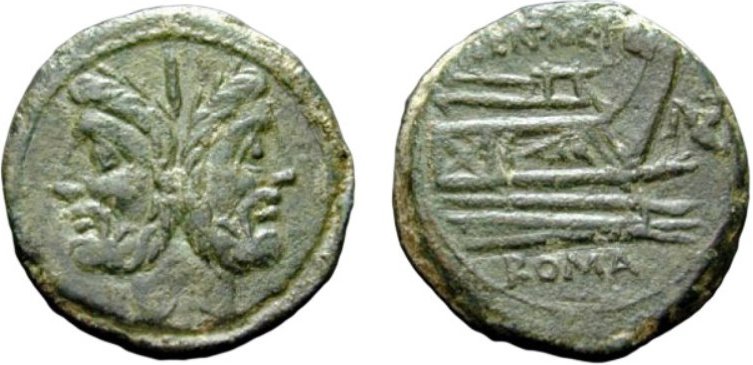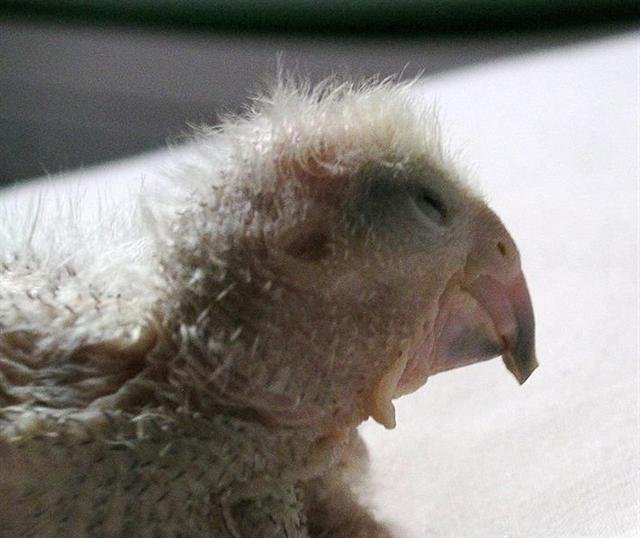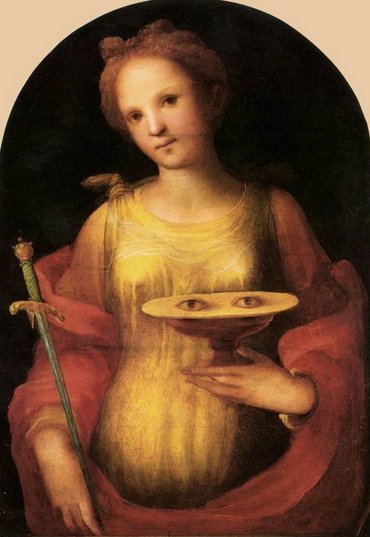In the C text glyph 384 + 18 (a Saturn number)
has a closed fist (nothing as yet counted) held high in front (Cb1-10)
... The practice of turning down the fingers,
contrary to our practice, deserves notice, as perhaps explaining
why sometimes savages are reported to be unable to count above
four. The European holds up one finger, which he counts, the
native counts those that are down and says 'four'. Two fingers
held up, the native counting those that are down, calls 'three';
and so on until the white man, holding up five fingers, gives
the native none turned down to count. The native is nunplussed,
and the enquirer reports that savages can not count above four
...
and from there to Alcyone there were a further 20 days.
402 + 20 = 422 (Cb2-6):
 |
 |
 |
 |
 |
 |
| *Ca14-18 |
*Ca14-19 |
*Ca14-20 |
*Ca14-21 (384) |
*Ca14-22 |
*Ca14-23 |
| te honu paka |
te henua |
honu kau |
te mata |
te honu |
kua heheu |
|
1h (15.2)
β Phoenicis (15.1), υ
Phoenicis, ι Tucanae (15.6), η Ceti, ζ Phoenicis (15.7) |
Al Batn Al Hūt-26 /
Revati-28 /
1-iku
MIRACH (Girdle)
= β Andromedae,
KEUN
MAN MUN (Camp's South
Gate) = φ Andromedae
(16.0), ANUNITUM
= τ Piscium (16.5),
REVATI (Abundant)
= ζ Piscium
(16.9) |
ν Phoenicis (17.4), κ
Tucanae (17.6) |
no star listed (18) |
ADHIL (Garment's Trail)
= ξ Andromedae (19.3), θ Ceti (19.7) |
KSORA (Knee)
= δ Cassiopeiae (20.1), ω Andromedae (20.6), γ Phoenicis (20.8) |
|
April 5 |
6 |
7 |
8 (464) |
9 |
10 (100) |

|
FEBRUARY
12 (408) |
13 |
2-14
(45) |
5 (46) |
16
(*332) |
|
*FEBRUARY 8 (*324) |
9 |
10 (41) |
11 |
12 (408) |
 |
 |
 |
 |
 |
|
Cb1-1 |
Cb1-2 |
Cb1-3 |
Cb1-4 (396) |
Cb1-5 |
|
E tupu - ki roto |
o
te hau tea |
ki
te henua - te maro |
rutua |
|
Al
Sharatain-1 /
Ashvini-1 /
Bond-16
/
Mahrū-sha-rishu-ku-1
(Front of the Head of
Ku) SEGIN
= ε Cassiopeia,
MESARTHIM = γ Arietis,
ψ Phoenicis (27.2),
SHERATAN
= β Arietis,
φ Phoenicis (27.4) |
ι
Arietis (28.0), λ Arietis (28.2), υ Ceti (28.8) |
ALRISHA
(The Knot)
= α
Piscium, χ Phoenicis (29.2),
ALAMAK
= γ Andromedae (29.7) |
Arku-sha-rishu-ku-2
(Back of the Head of Ku) 2h
(30.4)
κ
Arietis (30.3),
HAMAL =
α Arietis
(30.5)
ALKES (α
Crateris)
|
η
Arietis (31.9) |
|
April 17
(107) |
18 |
19 (*29) |
(*396 =
*30 + 366) |
21 (111) |
|
4-13 |
°April
14 (104) |
15 (*25) |
(*392 =
*26 + 366) |
17 (107) |
|
Gregorian equinox |
'March
22 |
23 |
24 |
Julian equinox |
|
"March 7 |
8 |
9 (68) |
(*354 =
*396 - 42) |
11 |
|
NAKSHATRA DATES: |
|
AUGUST
14 |
15 |
16
(*148) |
17 (229) |
18 |
|
*AUGUST
10 (222) |
11 |
12 (*144
= *212 - 68) |
13 (*290
/ 2) |
14 |
|
MUPHRID
= η Bootis
(210.1), ζ Centauri (210.3) |
φ Centauri (211.0), υ¹
Centauri (211.1), υ² Centauri (211.8), τ Virginis
(211.9) |
AGENA
= β Centauri (212.1), θ Apodis (212.5),
THUBAN (Dragon)
= α Draconis
(212.8) |
14h
(213.1)
π Hydrae, χ
Centauri (213.0),
MENKENT
= θ Centauri (213.1) |
Neck-2
(Dragon)
ASELLUS TERTIUS =
κ Bootis,
κ VIRGINIS, 14
Bootis (214.8) |
|
October
17 (290) |
18 |
19 (4 *
73) |
20 |
21
(*214) |
|
°October
13 |
14 |
15 (288
= 8 * 36) |
16 |
17
(*210) |
|
'September 20 |
21 (264) |
Equinox |
23 |
24
(*187) |
|
"September 6 |
7 |
8 (*171
= 9 * 19) |
9 (252 =
9 * 28) |
10 |
|
FEBRUARY 17 (7 * 59) |
18
(414 = 49 + 365) |
19 |
20 (*336) |
21 |
|
*FEBRUARY 13 (*329) |
2-14 |
15 (46) |
16 |
17 (413 = 14 * 29½) |
 |
 |
 |
 |
 |
|
Cb1-6 (398) |
Cb1-7 |
Cb1-8 |
Cb1-9 |
Cb1-10 (384 + 18) |
| te pahu |
rutua te maeva |
atua rerorero |
atua hiko ura |
hiko o tea |
|
ξ¹ Ceti (32.1) |
θ Arietis (33.3),
MIRA = ο Ceti
(33.7) |
no star listed (34) |
ξ Arietis (35.0), ρ
Ceti (35.4), ξ² Ceti (35.9) |
σ Ceti (36.9) |
|
April 22 |
23 |
24 |
25
(400 - 285) |
26 (*36) |
|
°April 18 |
19 |
20 |
21 (396 - 285) |
22 (*32) |
|
'March 26 |
27 |
28 |
29 (88) |
30 (*9) |
|
"March 12 |
13 |
3-14 (73) |
15 |
16 (*360) |
|
NAKSHATRA DATES: |
|
AUGUST 19 (231) |
20 |
21 |
22 |
23 (*155) |
|
*AUGUST 15 (227) |
16 |
17 |
18 |
19 (*151) |
|
Al Ghafr-13 /
Svāti-15 /
TAHUA-TAATA-METUA-TE-TUPU-MAVAE-6
(a pillar to stand
by)
15 Bootis (215.2),
ARCTURUS
(Bear-guard) = α Bootis
(215.4),
ASELLUS SECUNDUS = ι Bootis
(215.5),
SYRMA (Train of the Robe) = ι
Virginis, λ Bootis (215.6), η Apodis (215.8) |
ι
Lupi, 18 Bootis (216.3),
KHAMBALIA
(Crooked-clawed) = λ Virginis
(216.4), υ Virginis (216.5), ψ Centauri (216.6), ε Apodis
(216.8) |
ASELLUS PRIMUS
= θ Bootis (217.8) |
τ
Lupi, δ Oct. (218.1), φ Virginis (218.7)
FOMALHAUT
(α Piscis Austrini)
|
σ
Lupi (219.1), ρ Bootis (219.5),
HARIS (Keeper)
= γ Bootis (219.7) |
|
October 22 (295) |
23 (*216) |
24 |
25 |
26 |
|
°October 18 |
19 |
20 |
21 (*214) |
22 (295) |
|
'September 25 (268) |
26 |
27 |
28 |
29 (*192) |
|
"September 11 (254) |
12 |
13 |
14 (*177) |
15 |
|
14 |
 |
 |
 |
|
Cb2-1 |
Cb2-2 |
Cb2-3 (27) |
| Eaha te honu kua
tupu |
i to maitaki - o te
hau tea |
te hono huki - maro |
|
σ Persei (51.6) |
no star listed (52) |
ψ Persei (53.1)
ACRUX (α CRUCIS)
|
| May 11
(131) |
12 |
13 |
|
NUSAKAN (Pauper)
= β Cor. Bor. (234.0), κ¹ Apodis
(234.3), ν Bootis (234.7), ζ Librae (234.9) |
θ Cor.
Borealis (235.3), γ Lupi (235.6),
GEMMA = α Cor. Bor.,
ZUBEN ELAKRAB = γ Librae,
QIN
= δ Serpentis, ε Tr. Austr. (235.7), μ Cor. Borealis (235.8), υ
Librae (235.9)
SIRRAH (α Andromedae)
|
φ
Bootis (236.2), ω Lupi, τ Librae (236.3), ψ¹ Lupi (236.7), ζ Cor.
Borealis (236.9) |
|
'October 14 |
15 (288) |
16 |
|
"September 30 (273) |
"October 1 |
2 (*195) |
... Day 288 from the beginning of the year was, according
to our Gregorian calendar, ºOctober
15. At the time of Gregory XIII heliacal Nunki had been in
ºDecember 30 (364) and ºOctober 15 had been
at heliacal Thuban (with Hamal close to the Full Moon).
In Roman times 'October 15 was at
heliacal Gemma (with Sirrah culminating at midnight - at the opposite
side of the year compared to culminating Acrux). At the time of Bharani
"October 15 was at heliacal Antares - when Hotu Matua came to
Easter Island: ...
Hotu Matua came to the
island in the 15th day of the month Tagaroa Uri, which can be
translated into "October 15 ...
... Sir James Frazer, like
Gwion, has pointed out the similarity of 'door' words in all
Indo-European languages and shown Janus to be a 'stout guardian of the
door' with his head pointing in both directions. As usual, however, he
does not press his argument far enough. Duir as the god of the oak month
looks both ways because his post is at the turn of the year; which
identifies him with the Oak-god Hercules who became the door-keeper of
the Gods after his death. He is probably also to be identified with the
British god Llyr of Lludd or Nudd, a god of the sea - i.e. a god of a
sea-faring Bronze Age people - who was the 'father' of Creiddylad
(Cordelia) an aspect of the White Goddess; for according to Geoffrey of
Monmouth the grave of Llyr at Leicester was in a vault built in honour
of Janus. Geoffrey writes:
Cordelia obtaining the
government of the Kingdom buried her father in a certain vault which she
ordered to be made for him under the river Sore in Leicester
(Leircester) and which had been built originally under the ground in
honour of the god Janus. And here all the workmen of the city,
upon the anniversary solemnity of that festival, used to begin their
yearly labours.
Since Llyr was a pre-Roman
God this amounts to saying that he was two-headed, like Janus, and the
patron of the New Year; but the Celtic year began in the summer, not in
the winter. Geoffrey does not date the mourning festival but it is
likely to have originally taken place at the end of June ... What I take
for a reference to Llyr as Janus occurs in the closing paragraph of
Merlin's prophecy to the heathen King Vortigern and his Druids, recorded
by Geoffrey of Monmouth:
After this Janus shall never
have priests again. His door will be shut and remain concealed in
Ariadne's crannies.
In other words, the ancient
Druidic religion based on the oak-cult will be swept away by
Christianity and the door - the god Llyr - will languish forgotten in
the Castle of Arianrhod, the Corona Borealis.
This helps us to understand
the relationship at Rome of Janus and the White Goddess Cardea who is
... the Goddess of Hinges who came to Rome from Alba Longa. She was the
hinge on which the year swung - the ancient Latin, not the Etruscan year
- and her importance as such is recorded in the Latin adjective
cardinalis - as we say in English 'of cardinal importance - which
was also applied to the four main winds; for winds were considered as
under the sole direction of the Great Goddess until Classical times.
As Cardea she ruled
over the Celestial Hinge at the back of the North Wind around which, as
Varro explains in his De Re Rustica, the mill-stone of the
Universe revolves. This conception appears most plainly in the Norse
Edda, where the giantesses Fenja and Menja, who turn the monstrous
mill-stone Grotte in the cold polar night, stand for the White Goddess
in her complementary moods of creation and destruction. Elsewhere in
Norse mythology the Goddess is nine-fold: the nine giantesses who were
joint-mothers of the hero Rig, alias Heimdall, the inventor of the Norse
social system, similarly turned the cosmic mill ...

|
*MARCH 7 |
8 |
9 (68 = 136 - 68) |
10 (*355) |
 |
 |
 |
 |
| Cb2-4
(420) |
Cb2-5 (29) |
Cb2-6 |
Cb2-7 |
| te ua |
koia ra |
kua tuku ki to mata
- ki tona tukuga |
e kiore - henua -
pa rei |
|
δ Persei (54.7) |
Al Thurayya-27 /
Krittikā-3 |
MENKHIB
= ζ Persei (57.6) PORRIMA (γ Virginis)
|
|
TAU-ONO
(Six Stones) ATIKS
= ο Persei, RANA
= δ Eridani (55.1),
CELAENO
(16 Tauri),
ELECTRA (17),
TAYGETA
(19), ν Persei (55.3),
MAIA
(20), ASTEROPE
(21), MEROPE
(23) (55.6) |
Temennu-3 (Foundation Stone)
Hairy Head-18
(Cockerel)
ALCYONE
(56.1), PLEIONE
(28 Tauri), ATLAS
(27) (56.3) |
|
May 14 (*54) |
15 (500) |
16 (136) |
17 (*57) |
|
"April 3 (*13) |
4
(459) |
5 (95 = 136 - 41) |
6 (*16) |
|
NAKSHATRA DATES: |
|
6 (249 = 66 + 183) |
*SEPTEMBER 7 |
8 |
9 (*172 = *240 - *68) |
|
κ Librae
(237.2), ι Serpentis (237.4), ψ² Lupi, ρ Oct. (237.5), γ
Cor. Borealis, η Librae (237.7), COR
SERPENTIS
= α Serpentis (237.9) |
π Cor. Borealis,
UNUK ELHAIA (Necks of
the Serpents) = λ Serpentis
(238.1), CHOW
= β Serpentis (238.6) |
κ
Serpentis (239.3), δ Cor. Borealis,
TIĀNRŪ
= μ Serpentis (239.5), χ Lupi, (239.6), ω Serpentis (239.7),
BA
= ε Serpentis, χ Herculis (239.8). κ Cor. Borealis, ρ Serpentis
(239.9) |
λ
Librae (240.0), β Tr. Austr. (240.3), κ Tr. Austr. (240.4), ρ
Scorpii (240.8) |
|
'October 17
(290) |
18 (*211 = *238 - 27) |
(292 = 136 + 183 - 27) |
20 |
|
"October 3 (*196) |
4
(277) |
5 |
6 |
| Tuku
1. To leave something lying spread on the ground; to
spread, unfurl, unroll something on the ground; tukuga, mat
spread on the ground; tukuga tagata, mat on which have been
put pieces of cooked human flesh. 2. Tuku kupega, a fishing
technique: two men drag along the top of a fishing net doubled up,
spread out on the bottom of a small cove, trapping the fish into the
net; tukutuku, to fish while swimming, holding a
basket-shaped net. 3. Tuku huri, to sit with one's buttocks
resting on one's heels, soles flat on the ground. Figuratively:
ka tuku! pay attention! (literally: sit still!). 4. Tuku
rîu, to sit in the posture typical of choir singers in rîu
festivals or singing festivals in general, which was sitting on
one's heels. Tukuturi, to sit with one's buttocks resting on
one's heels, soles flat on the ground. Vanaga.
To give, to let go, to deliver, to accord, to go
back to the boat, to dedicate; rima tuku, to bend at the
elbow (? tuke). P Pau.: tuku, to lay down, to place,
to deliver up. Mgv.: tuku, to give, to deliver, to let alone.
Mq.: tuku, to give, to let go. Ta.: tuu, id. Tukuga,
plate, ladle, pottinger, legacy, to dedicate (tukaga).
Churchill.
H.: Ku'u ku'u 1. Redup. of ku'u 1;
to let down gradually, slack off a little at a time. See ala
ku'uku'u. Ho'o ku'uku'u lenient, permissive; to pay out,
as a fishline. Kī ho'oku'uku'u, slack key, as on a guitar (kī
hō'alu is more common). Ua ho'oku'uku'u loa na mākua i keiki,
parents are too lenient with children. (PPN tukutuku.)
2.Small, short-legged spider, so called because it lowers itself (ku'u)
on a single string fiber. Ke alanui a ke ku'uku'u, the path
of the spider (a name for the Equator). Ho'o ku'u ku'u, same
as above. 3. Boomerang. 'U'uku, tiny, small; few. 'U'uku
iho, undersized, smaller. Ho'o 'u'uku, to make small,
reduce, lessen. Wehewehe.
Maori: tuku,
to subside, to settle down. Tahiti:
tuutuu, to slacken or ease a rope. Hawaii:
kuu, to let down, to
slacken. Tonga: tuku, to
slacken, to let go as a rope;
tukutuku, to sink in the sea. Futuna:
tuku, to put down. Niuē:
tuku, to bury. Rarotonga: tuku, to let down, to let
out, to drop down. Mangareva: tuku, to throw the fishing net
of fillet. Paumotu: tuku, to lay down. Sikayana: tuku,
to put down. Nukuoro: tuku, to permit, to allow. Manahiki,
Fakaafo: tuku, to place. Nuguria: tuku, to set.
Rapanui: tuku, to give, to accord. Churchill 2. |
There were turtle (honu) glyphs distributed from 1h (*15), the first
5 of them on side a with 1 more between Sheratan in Aries and Alrisha in
Pisces. Then there was a gap until the beginning of line Cb2, where 2 more
were added. 6 + 2 = 8.
From Cb1-6 (Jupiter's 16) to Alyone at Cb2-6 (26 = 2 * 13)
there were 24 days, and from 1h there were 41 right ascension nights,*56 -
*15 = *41 (as in Bharani, the place for birth). I think we should say days
when discussing the path of the Sun and nights when we are relying on the
positions of the stars.

The C text was probably here documenting where the Pleiades
year was beginning:
... In view of the almost
universal prevalence of the Pleiades year throughout the Polynesian area it
is surprising to find that in the South Island and certain parts of the
North Island of New Zealand and in the neighboring Chatham Islands, the year
began with the new Moon after the early morning rising, not of the Pleiades,
but of the star Rigel in Orion ...
There were wooden clappers early in April and these
proclaimed it was time for extinguishing the lights and to eat only cold food,
because it was the beginning of the December solstice.
... In China, every year about
the beginning of April, certain officials called Sz'hüen used of old
to go about the country armed with wooden clappers. Their business was to
summon the people and command them to put out every fire. This was the
beginning of the season called Han-shih-tsieh, or 'eating of cold
food'. For three days all household fires remained extinct as a preparation
for the solemn renewal of the fire, which took place on the fifth or sixth
day after the winter solstice [Sic!]. The ceremony was performed with great
pomp by the same officials who procured the new fire from heaven by
reflecting the sun's rays either from a metal mirror or from a crystal on
dry moss. Fire thus obtained is called by the Chinese heavenly fire and its
use is enjoined in sacrifices: whereas fire elicited by the friction of wood
is termed by them earthly fire, and its use is prescribed for cooking and
other domestic purposes ...
Like archaic China and certain
Amero-Indian societies, Europe, until quite recently, celebrated a rite
involving the extinguishing and renewal of domestic fires, preceded by
fasting and the use of the instruments of darkness. This series of events
took place just before Easter, so that the 'darkness' which prevailed in the
church during the service of the same name (Tenebrae), could
symbolize both the extinguishing of domestic fires and the darkness which
covered the earth at the moment of Christ's death. In all Catholic countries
it was customary to extinguish the lights in the churches on Easter Eve and
then make a new fire sometimes with flint or with the help of a
burning-glass. Frazer brings together numerous instances which show that
this fire was used to give every house new fire. He quotes a
sixteenth-century Latin poem in a contemporary English translation, from
which I take the following significant lines:
On Easter Eve the fire all is
quencht in every place, // And fresh againe from out the flint is fecht with
solemne grace.
Then Clappers cease, and belles
are set againe at libertée, // And herewithall the hungrie times of fasting
ended bée ...

Probably it was thought how once upon a time - when
the stars were fixed in their proper time order - Porrima had been placed
with her midnight culmination in right ascension night number 355 (as in December 21).

| Po
1. Night; to get dark, to fall (of night): he-po,
it is getting dark. Formerly used, with or without raá,
in the meaning of a whole day: po tahi, one day; katahi te
kauatu marima po, fifteen days; po tahi raá, first day of
the week; po rua raá, po toru raá, second, third day, etc. 2.
Alone or as po nui, used to express the idea of good luck,
happiness. He-avai-atu au to'ou po, I wish you good luck
(when taking leave of someone). Very common was this parting
formula: aná po noho ki a koe! good luck to you! Po-á, morning;
i te po-á, in the morning; i te po-era-á, very early
in the morning. Po-ará, quickly, rapidly, swiftly: he-iri
po-ará, go up quick; he-ta'o itau umu era po-ará, he
cooked it quickly. Po-e-mahina, formerly used of
sleep-walkers (haha a po). Vanaga.
1. Darkness, night, late; po haha, dark
night, gloom. P Tu. po-tagotago, darkness. Mgv., Mq., Ta.:
po, darkness, night. 2. Calendar day; po e rua, Tuesday;
po o te tagata, life. P Pau., Mgv., Mq., Ta.: po,
calendar day. Churchill. |
| Rima
1. Hand, also, but improperly, fingers, forearm;
te ko mu'a o te rima, palm of the hand; te ko tu'a o te rima,
back of the hand; rima hakaturu, generous, liberal,
munificent; tagata rima pu'a, helper; rima hakakau,
generous hands, open-handed person; rima matu'a neanea,
thumb. 2. Fifth; e-rima, ka-rima, five. Vanaga.
1. Five. P Mgv., Ta.: rima, id. Mq.: ima,
id. 2. Arm, hand; rima atakai, obliging, kind, generous, a
gift, rima tuku, elbow, rima omo, infidelity,
faithless, unfaithful, rima o te kahu, sleeve, kakari rima,
wrist. P Pau.: rima, hand, arm. Mgv.: rima, hand, arm,
paw, finger. Mq.: ima, hand, arm. Ta.: rima, arm,
hand, finger. Rimahakaviriviri, fist, to clench the fist, a
blow of the fist. Rimahati, one-armed. Rima ko manaroa,
little finger T. Rimamatua neanea, thumb. Rimaroaroa
tahaga, middle finger T. Rimatitiri, to walk with the
hands behind the back. Rimaruru, to clasp hands. Rimatuhi
henna (?) index finger T. Rimatuhi a hana, finger ring T
(? ring finger). 3. To lead into error; rimaetua,
supernatural, Mq.: imaima, that which returns after a man's
death, Ta.: rimaatua, plague, dissension, mortal illness.
Churchill. |
|





















